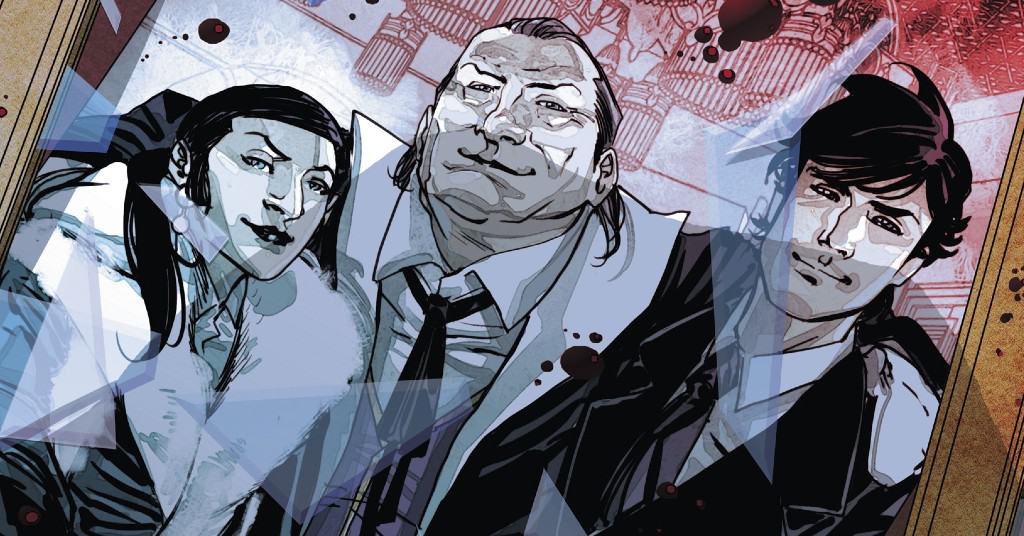The Penguin #9
Recap
The Penguin's return to Gotham City has been a homecoming in more ways than one! Meeting his ruthless, bloodthirsty twin children--the ones who inherited his empire, including the Iceberg Lounge--is a family reunion for the ages! (Oh, and it's bloody!)
Review
Batman is the world’s greatest detective. Usually that skill set helps him catch the villain no matter what they’ve done. But this time the villain is making Batman’s skills work for him. The series plays with genre conventions again in Penguin #9 as the detective becomes the antagonist.
The issue opens with a bang. Major Victory and Silent Majority plant a bomb in the Martha Wayne Day Care Center at the beginning of Penguin #9. The bomb, along with eleven others, explode in Gotham City over the same night. Batman demands answers from Oswald who insist it was his children, Aidan and Addison. Batman is certain that Oswald is lying, but his investigation points in that direction all the same. And while that is going on, Agent Espinoza returns to remind Oswald that he works for her.
Penguin #9 takes everything that makes Batman an effective hero and turns it against him. Batman knows Oswald is playing him even though all his talents as a detective tell him otherwise. This plays into one of the series’ charms which is that Oswald is played straight as a protagonist. He’s as smart as any hero with their own series might be. But from this series’ point of view, Batman is the antagonist, and it’s satisfying to see him manipulated. Part of the story’s success in this regard is how Penguin built up to it. King established Oswald as a powerful character in his own right before developing the relationship with Batman. It’s not a foregone conclusion that Batman will thwart Oswald’s schemes as evidenced by how Oswald uses him here.
King touches on the underlying plot that got Oswald sent back to Gotham. There isn’t much “there” there as far as this issue is concerned, though it does lead to a surprisingly funny sequence where Espinoza’s captions are filled with an almost never ending string of censored expletives. Penguin #9’s last page, which Espinoza’s return leads into, delivers a surprise. The captions on it are ambiguous in the sense that they might refer specifically to the emotion of the moment or portend a possible weakness for Oswald going forward. Ambiguity is something that King often plays with skillfully, opening up possibilities and dropping in red herrings to obscure where the story is truly going.
There is a scene between Bruce Wayne and Lisa St. Claire that has a wonderful tension. The dialogue is laced with subtext. But more than that, the reader is aware from Penguin #7 that Oswald knows something about Bruce Wayne. Did he tell Lisa at some point off panel? The reader has no way to know.
De Latorre’s art is always detailed when it comes to characters. The more liberal lines and shadows he uses on faces lets him communicate a great deal with relatively subtle changes. In the opening scene with Oswald and Batman, Oswald runs through a gamut of emotions ranging from superior to indignant to fearful. In some cases De Latorre communicates the changes with little more than a change in eyeline. Batman lifts Oswald up and the diminutive man ends up looking down on him with contempt. After Batman throws him down, Oswald’s eyeline shifts to down and away relative to where Batman stands. More so than any action Batman has taken, the subtle changes on Oswald’s face communicate the shift in power that’s just taken place.
The scene between Bruce Wayne and Lisa St. Claire is another example of De Latorre communicating power dynamics with subtle art. As with storylines writ large, King’s dialogue can be ambiguous and full of subtext. In the encounter between Bruce and Lisa, De Latorre keeps a smile plastered on Lisa’s face almost the whole time. And the smile is one of those that radiates all the way to her eyes thanks to a few lines that add contour to her cheeks and around her eyes. Thanks to that unending smile, it’s easy to read Lisa as being totally in control of the conversation.
Penguin #9’s final two scenes take place amidst a rain storm. De Latorre doesn’t go overboard on the rain lines. Rather, it’s Maiolo who captures the atmosphere of a cold night’s downpour. Everything has a slight aura, similar in color to the surroundings (yellow when amidst the lights of Gotham and blue when away from them) but lighter in intensity as though the rain drops’ impact is creating a light mist.
Maiolo also continues playing with background colors that correspond to characters. A muted version of Lisa St. Clair’s magenta background is used during the scene featuring her and Bruce Wayne. It further suggests that this is Lisa’s scene to command rather than Bruce’s.
The issue features two explosions, both of which call for a BLAM. Cowles does a good job differentiating their force thanks to the variation of size and location of the sound effect relative to the blast. His color choice for the font, white but dirtied up with gray shading, makes the letters look almost like debris.
Final Thoughts
As noted in prior reviews, Penguin is a series that plays with the conventions of crime fiction and its various subgenres. This issue is almost a reverse detective story with the antagonist being the detective and seemingly being misled. Thanks to this and other story developments, including the surprising ending, Penguin #9 successfully throws a few curve balls at readers.
The Penguin #9: The Bad Guy Detective
- Writing - 9/109/10
- Storyline - 8.5/108.5/10
- Art - 9/109/10
- Color - 9/109/10
- Cover Art - 8.5/108.5/10
